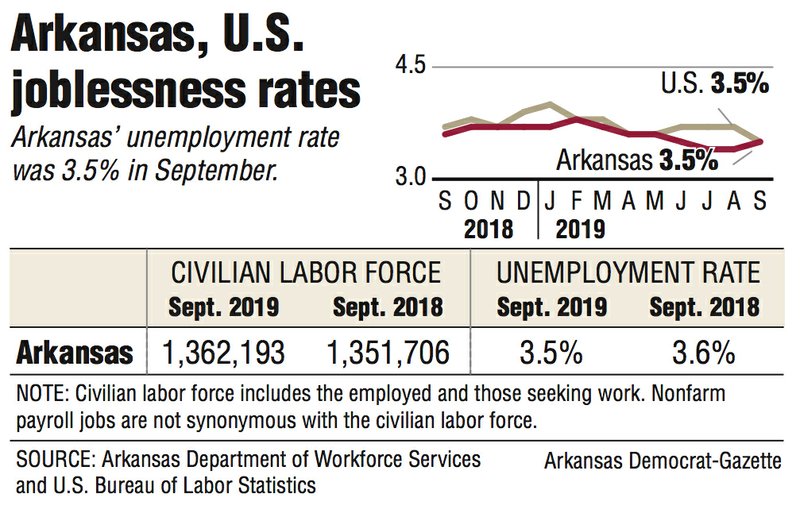Arkansas' unemployment rate ticked up to 3.5% in September, or a 10th of a percentage point from the previous month, according to U.S. Department of Labor data released Friday.
It marked the first month the state's joblessness rate has risen since February, when it was 3.8%. It is also lower than the state's September 2018 rate of 3.6%.
While there may be a rise, Michael Pakko, chief economist at the University of Arkansas at Little Rock, said the "world's not coming to an end."
"Just for fun, I carried the calculation out," he said. "Basically it changed from 3.44% in August to 3.46% in September."
The state's civilian labor force was relatively flat during the period, data shows. There were 1,362,193 workforce participants in September, which is 319 fewer than in August. Broken out -- employment numbers fell by 552 month-to-month, while the number of unemployed rose by 233.
Relatively speaking, "those are tiny numbers," Pakko said.
The U.S. unemployment rate fell two-tenths of a percentage point to 3.5% during the period, data shows.
Greg Kaza, executive director of the Arkansas Policy Foundation, a conservative think tank, said 26 states had lower unemployment rates than Arkansas in September, citing Bureau of Labor Statistics data.
Four of them border Arkansas, he said, Missouri (3.1%), Oklahoma (3.2%), Tennessee (3.4%) and Texas (3.4%).
Arkansas' nonfarm payroll jobs rose 16,600 month-to-month, totaling 1,286,200 jobs in September, data shows. Most of that was seasonal and related to the return of teachers and staff members at public and private schools and universities, Pakko said.
In the surveys taken to collect monthly unemployment data, one of the questions is whether a person has worked for pay in the past three weeks or more, Pakko said, placing teachers and school staff members who have 9-month contracts in the unemployed category during the summer months.
Of the jobs added in September, 13,000 were in the government sector; 4,100 in the educational and health services sector; 2,200 in the professional and business services sector; and 1,200 in the construction sector, the report shows. Meanwhile, manufacturing jobs fell by 1,400.
That was a disappointment, Pakko said.
"It's been growing strong the past couple of years and when you see a decline like that, it feels like a setback," he said, although year-over-year figures show a solid gain in manufacturing.
In a labor force report, the state's division of workforce services said most of the job losses were in durable goods, related to reductions in "fabricated metal product manufacturing and in machinery manufacturing."
Compared with September 2018, nonfarm payroll jobs in the state went up 15,900, with gains in seven key industry sectors and mild declines in three. Employment in leisure and hospitality rose 4,700 (mostly in food services), data shows. Construction added 3,500 jobs. Educational and health services increased by 2,900 (mostly in day care and vocational rehabilitation services). Financial activities jobs rose 2,500, and more than 1,000 jobs were each added in government, manufacturing and trade-transportation-utilities.
A loss of less than 1,000 jobs was reported in each of the following sectors: professional and business services (-800), mining and logging (-200), and other services (-800).
Surprisingly, Pakko said jobs in the professional and business services sector were lagging, even with the strong month-to-month gain reported for September.
Subsector data shows a gain of 1,500 jobs in management of companies; a loss of 300 professional, scientific and technical jobs; and a loss of 2,000 jobs in administrative and support services.
"It looks like that particular set of subsectors are slowing or stabilizing at this point," Pakko said.
Business on 10/19/2019
